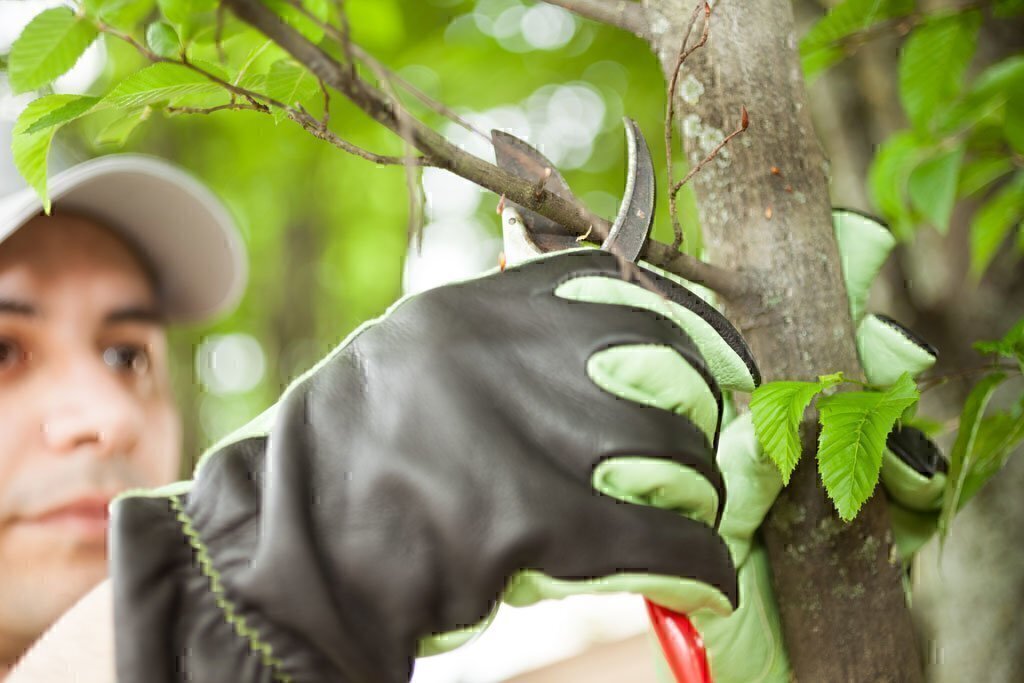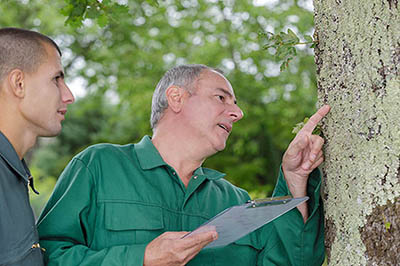How to Tell If Your Trees Need TLC
Last updated April 2024
You don’t have to be an expert to spot many potential tree problems. Like most plants, trees have ways of indicating distress. Examine your trees several times a year for the following:
- Discolored leaves and thinning in the tree’s crown.
- Roots pulled loose from the ground or fungus on roots and main trunk.
- Often sheds dead branches, especially if they are more than two inches in diameter.
- Deep vertical cracks on opposite sides of the main trunk.
- Sawdust on the trunk from wood-boring insects.
- A trunk that noticeably leans in one direction and a branch canopy that is not balanced-looking.
- Other unusual deformities and deposits on leaves, limbs, or bark.
 Other reasons for tree work include eliminating the risk to your house—or to electrical or other utility wires—from rubbing or precarious overhanging limbs; letting light and breezes more readily reach your house, garden, or lawn; and protecting foundations and drainage systems from invading roots.
Other reasons for tree work include eliminating the risk to your house—or to electrical or other utility wires—from rubbing or precarious overhanging limbs; letting light and breezes more readily reach your house, garden, or lawn; and protecting foundations and drainage systems from invading roots.
In many cases, the problem and the solution will be obvious—say, removing specific limbs or spraying for an easily recognizable pest. But sometimes diagnosing and treating trees can be difficult and you need expert advice.
One source is a tree care service, which will send a representative to your home to offer recommendations and a treatment proposal. But don’t assume that all tree care companies can determine what’s wrong and prescribe the right solution.
Many trees are lost because they don’t receive the right care—often because they are inaccurately diagnosed or because self-styled experts offer bad advice. Tree care companies sometimes create problems by wiping out pests’ natural predators or spraying unnecessarily for problems that would have cured themselves.
The best strategy is to get more than one opinion. Invite several companies to offer estimates, and ask them to explain what they plan to do and why. You can also get advice from the sources listed below.
Alternatively, you can find members of the American Society of Consulting Arborists (ASCA) on its website. To join, an arborist must have at least five years’ experience in arboriculture and a four-year degree in arboriculture (or closely related field) or a corresponding number of continuing education credits. ASCA members must also receive 30 continuing education units every two years to maintain their membership status. Additional requirements for registered ASCA members include successful completion of the ASCA’s Consulting Academy program and the successful review of three consulting reports.
The International Society of Arboriculture (ISA) has similar requirements for certification. An arborist must have at least three years of experience in arboriculture (or a combination of experience and education) and must also pass an exam. Certification is valid for three years; a certified arborist must then accumulate 30 continuing education credits every three years to maintain certification or retake the exam every three years to recertify.
Although certified ASCA and ISA members ordinarily operate or work for tree care companies, you can ensure objectivity by hiring one strictly as a consultant and explaining that you won’t necessarily use his or her company to perform the services it recommends.
Naturally, the effort you put into getting sound advice will depend on how highly you value your trees and how much you expect the work to cost.
 Expert Advice
Expert Advice
Your county’s cooperative extension office has master gardeners who can diagnose plant problems—you can even bring them specimens. Other local sources of gardening expertise:
University of Minnesota Extension
612-624-1222
Minnesota Landscape Arboretum
3675 Arboretum Drive
Chaska, MN 55318
612-624-2200
Minnesota Nursery & Landscape Association
1813 Lexington Avenue N.
Roseville, MN 55113
651-633-4987
Minnesota State Horticultural Society
1935 County Road B2 W, Suite 125
Roseville, MN 55113
651-643-3601

